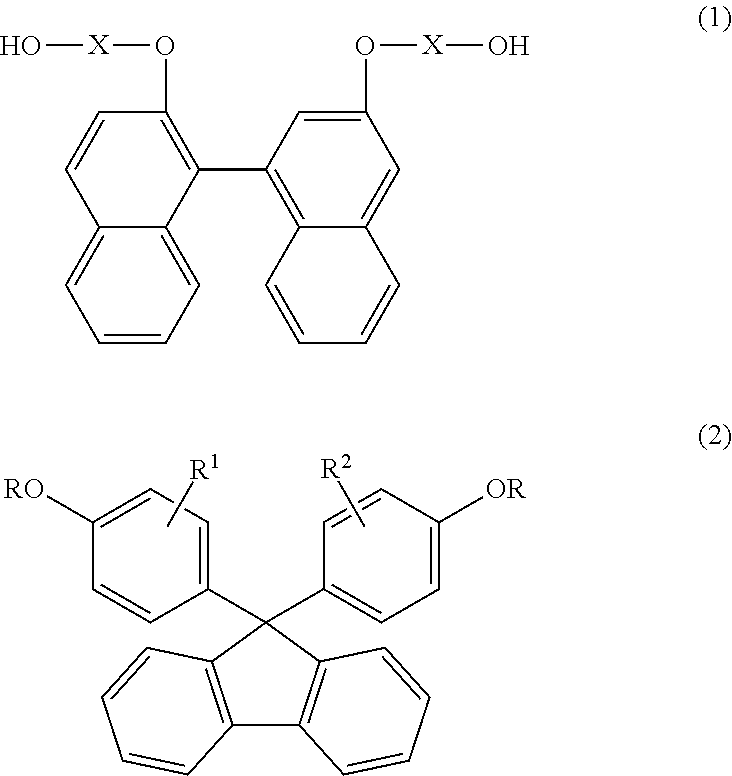Resin produced by polycondensation, and resin composition
a technology of polycondensate and polymer, which is applied in the direction of instruments, optical elements, light-sensitive devices, etc., can solve the problems of poor molding processability, high material cost of optical glasses, and low productivity, and achieve high refractive index, excellent optical characteristics, and low abbe number
- Summary
- Abstract
- Description
- Claims
- Application Information
AI Technical Summary
Benefits of technology
Problems solved by technology
Method used
Image
Examples
example 1
[0283]13.4 g (0.035 mol) of 2,2′-bis(2-hydroxyethoxy)-1,1′-binaphthalene (hereinafter sometimes abbreviated as “BHEBN”), 35.6 g (0.081 mol) of 9,9-bis(4-(2-hydroxyethoxy)phenyl)fluorene (hereinafter sometimes abbreviated as “BPEF”), 25.0 g (0.117 mol) of diphenyl carbonate (hereinafter sometimes abbreviated as “DPC”) and 8.8×10−5 g (1.0×10−6 mol) of sodium hydrogen carbonate were put into a 300 ml four-neck flask equipped with a stirrer and a distillation apparatus, and it was heated to 180° C. under nitrogen atmosphere (760 mmHg). 10 minutes after the start of heating, complete dissolution of the raw materials was confirmed. After that, stirring was performed for 110 minutes under the same conditions. After that, the pressure reducing degree was adjusted to 200 mmHg, and simultaneously, the temperature was increased to 200° C. at a rate of 60° C. / hr. During this, the start of distillation of by-produced phenol was confirmed. After that, the temperature was kept for 20 minutes to pe...
example 2
[0284]The operation was carried out in a manner similar to that in Example 1, except that the amounts of BHEBN, BPEF, DPC and sodium hydrogen carbonate were changed to 17.1 g (0.046 mol), 30.1 g (0.069 mol), 25.0 g (0.117 mol) and 8.7×10−5 g (1.0×10−6 mol), respectively, and a polycarbonate resin produced was taken out. In the polycarbonate resin, the amount of residual phenol was 60 ppm, and the amount of residual DPC was 250 ppm.
example 3
[0285]The operation was carried out in a manner similar to that in Example 1, except that the amounts of BHEBN, BPEF, DPC and sodium hydrogen carbonate were changed to 30.0 g (0.080 mol), 15.1 g (0.034 mol), 25.0 g (0.117 mol) and 8.7×10−4 g (1.0×10−6 mol), respectively, and a polycarbonate resin produced was taken out. In the polycarbonate resin, the amount of residual phenol was 120 ppm.
PUM
| Property | Measurement | Unit |
|---|---|---|
| refractive index | aaaaa | aaaaa |
| Abbe number | aaaaa | aaaaa |
| Abbe number | aaaaa | aaaaa |
Abstract
Description
Claims
Application Information
 Login to View More
Login to View More - R&D
- Intellectual Property
- Life Sciences
- Materials
- Tech Scout
- Unparalleled Data Quality
- Higher Quality Content
- 60% Fewer Hallucinations
Browse by: Latest US Patents, China's latest patents, Technical Efficacy Thesaurus, Application Domain, Technology Topic, Popular Technical Reports.
© 2025 PatSnap. All rights reserved.Legal|Privacy policy|Modern Slavery Act Transparency Statement|Sitemap|About US| Contact US: help@patsnap.com



